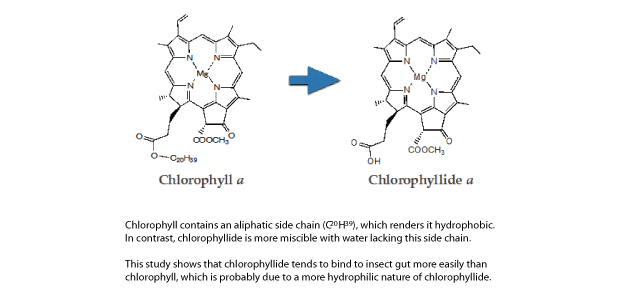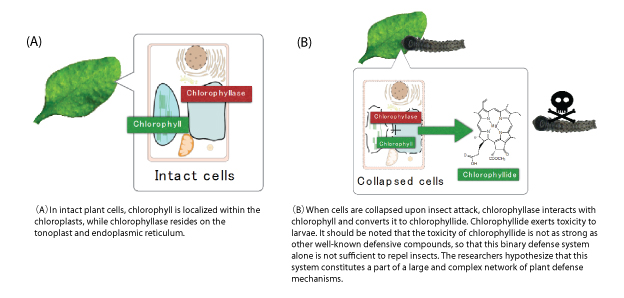Plants use a chlorophyll derivative for defense against chewing herbivores
Research Press Release | February 05, 2015
-
 Fig. 1: Structures of chlorophyll and chlorophyllide
Fig. 1: Structures of chlorophyll and chlorophyllide -
 Fig. 2: A binary defense system composed of chlorophyllase and chlorophyll
Fig. 2: A binary defense system composed of chlorophyllase and chlorophyll
| Press Release | ||
|---|---|---|
| Key Points | ・Enzyme chlorophyllase in plants was shown to produce chlorophyllide from chlorophyll when insects ate the leaves of the plant (when plant cells collapsed inside the body of the insect).
・Regarding insect larvae that ate leaves which had an artificially increased amount of the chlorophyllase content, their mortality rate increased. ・Insect larvae which were fed leaves with an increased amount chlorophyllide demonstrated delayed growth. ・This study demonstrated that the chlorophyll originally used by plants for photosynthesis, is also used for protection from leaf eating pests. |
|
| Overview |
Enzyme chlorophyllase in plants possesses the activity to convert chlorophyll, which is hydrophobic (non-water soluble), to chlorophyllide, which is hydrophilic (water soluble) (Fig.1). The existence of this enzyme has been known for over a hundred years, but its role in plants was not known. The joint research team of the Institute of Low Temperature Science at Hokkaido University, Nippon Soda Co., Ltd., the University of Zurich, and Kyoto University, clearly identified the existence of chlorophyllase in vacuoles and the endoplasmic reticulum of the plant cell, and that chlorophyllase converts chlorophyll to chlorophyllide immediately after the plant cell collapses. Using recombinant DNA technology, the content of chlorophyllase in the cell was increased. When these leaves were given to insect larvae (Spodoptera litura), the percentage of larvae which died after eating the leaves increased. And when chlorophyllide was mixed in feed given to the larvae, growth was suppressed. Furthermore, it was shown that chlorophyllide binds to insect gut more easily than chlorophyll. According to these results, when the leaves of plants are eaten by insect larvae, it is suggested that plants defend themselves by converting chlorophyll, which abundantly exists in leaves, into chlorophyllide. |
|
| Inquiries |
Ryouichi Tanaka, Associate Professor, Institute of Low Temperature Science, Hokkaido University TEL & FAX: +81-11-706-5494 E-mail: rtanaka@lowtem.hokudai.ac.jp Tanaka Lab: Functional studies of photosynthesis and its related plant metabolism |
|
|
Japanese Link |
植物は葉緑素を昆虫から身を守るために利用している | |
| Publications | Re-examination of chlorophyllase function implies its involvement in defense against chewing herbivores, Plant Physiology (2015.1.12) | |
